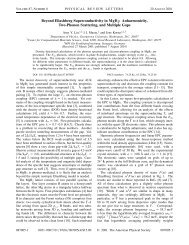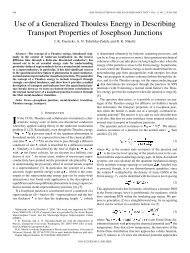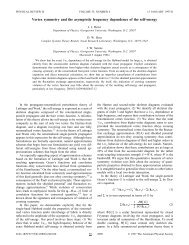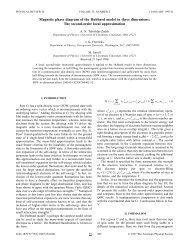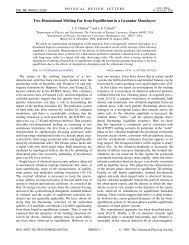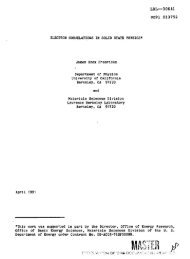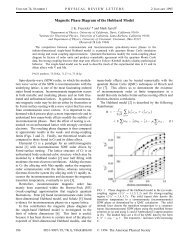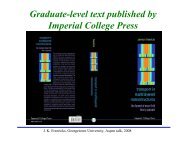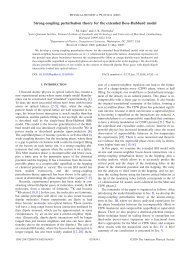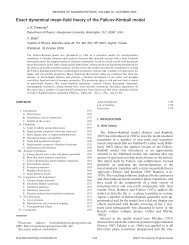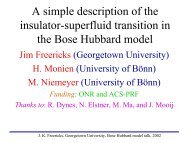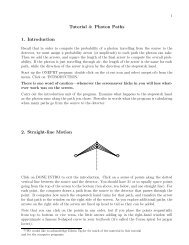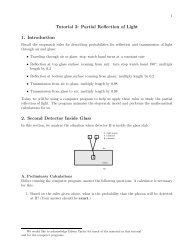Strong-coupling perturbation theory for the two-dimensional Bose ...
Strong-coupling perturbation theory for the two-dimensional Bose ...
Strong-coupling perturbation theory for the two-dimensional Bose ...
Create successful ePaper yourself
Turn your PDF publications into a flip-book with our unique Google optimized e-Paper software.
PHYSICAL REVIEW B<br />
VOLUME 60, NUMBER 4<br />
15 JULY 1999-II<br />
<strong>Strong</strong>-<strong>coupling</strong> <strong>perturbation</strong> <strong><strong>the</strong>ory</strong> <strong>for</strong> <strong>the</strong> <strong>two</strong>-<strong>dimensional</strong> <strong>Bose</strong>-Hubbard model<br />
in a magnetic field<br />
M. Niemeyer<br />
Physikalisches Institut der Univerität Bonn, Nußallee 12, D-53115 Bonn, Germany<br />
J. K. Freericks<br />
Department of Physics, Georgetown University, Washington, D.C. 20057<br />
H. Monien<br />
Physikalisches Institut der Univerität Bonn, Nußallee 12, D-53115 Bonn, Germany<br />
Received 15 December 1998<br />
The <strong>Bose</strong>-Hubbard model in an external magnetic field is investigated with strong-<strong>coupling</strong> <strong>perturbation</strong><br />
<strong><strong>the</strong>ory</strong>. The lowest-order secular equation leads to <strong>the</strong> problem of a charged particle moving on a lattice in <strong>the</strong><br />
presence of a magnetic field, which was first treated by Hofstadter. We present phase diagrams <strong>for</strong> <strong>the</strong><br />
<strong>two</strong>-<strong>dimensional</strong> square and triangular lattices, showing a change in shape of <strong>the</strong> phase lobes away from <strong>the</strong><br />
well-known power-law behavior in zero magnetic field. Some qualitative agreement with experimental work<br />
on Josephson-junction arrays is found <strong>for</strong> <strong>the</strong> insulating phase behavior at small fields.<br />
S0163-18299907627-4<br />
I. INTRODUCTION<br />
The simplest model of strongly interacting bosons is <strong>the</strong><br />
<strong>Bose</strong>-Hubbard model BHM, which has been used to describe<br />
superfluid helium, 1 Cooper pairs in thin granular superconducting<br />
films, 2 and Josephson-junction arrays. 3 Much<br />
<strong>the</strong>oretical work has concentrated on <strong>the</strong> phase diagram of<br />
<strong>the</strong> BHM in zero magnetic field 4 because of <strong>the</strong> technical<br />
problems associated with introducing an external magnetic<br />
field such as <strong>the</strong> sign problem in quantum Monte Carlo<br />
simulations. Experimentalists, on <strong>the</strong> o<strong>the</strong>r hand, have concentrated<br />
on studying systems in an external magnetic field<br />
because <strong>the</strong> phase transition can be tuned by adjusting <strong>the</strong><br />
magnetic field ra<strong>the</strong>r than changing <strong>the</strong> samples measured. 5,6<br />
We study <strong>the</strong> BHM on <strong>two</strong>-<strong>dimensional</strong> lattices in a perpendicular<br />
magnetic field by extending <strong>the</strong> strong-<strong>coupling</strong> <strong>perturbation</strong><br />
<strong><strong>the</strong>ory</strong> <strong>for</strong> <strong>the</strong> field-free case. 7 This <strong>the</strong>oretical technique<br />
can incorporate magnetic-field dependence in a<br />
straight<strong>for</strong>ward manner and is useful in studying field-tuned<br />
transitions. We concentrate on pure systems in this contribution<br />
and do not include any effects due to disorder. We<br />
present zero-temperature phase diagrams, study excitationgap<br />
energies, calculate <strong>the</strong> dynamical critical exponent z<br />
<strong>for</strong> small fields assuming that <strong>the</strong>re is critical behavior in a<br />
field, and compare our <strong>the</strong>oretical results with experimental<br />
ones.<br />
The BHM contains <strong>the</strong> key physics of a many-particle<br />
bosonic system with competing potential and kinetic-energy<br />
effects. The typical zero-temperature phase diagram <strong>for</strong> <strong>the</strong><br />
nonmagnetic case shows incompressible Mott-insulating<br />
MI phases surrounded by compressible superfluid phases<br />
SF. 4 The insulator to superfluid transitions at <strong>the</strong> tip of <strong>the</strong><br />
lobes where <strong>the</strong> density remains constant are driven by<br />
quantum phase fluctuations, while those at <strong>the</strong> sides of <strong>the</strong><br />
lobes where <strong>the</strong> density varies are driven by density fluctuations,<br />
i.e., particle or hole excitations. Introducing a magnetic<br />
field is expected to increase <strong>the</strong> region of <strong>the</strong> MI phase<br />
because <strong>the</strong> localizing effect on <strong>the</strong> itinerant bosons reduces<br />
<strong>the</strong> stability of <strong>the</strong> SF phase.<br />
We consider bosons with a total spin of 0. The only effect<br />
of a perpendicular magnetic field H is <strong>the</strong>n on <strong>the</strong> orbital<br />
motion of <strong>the</strong> bosons, which effects changes in <strong>the</strong> phase of<br />
<strong>the</strong> hopping matrix Tˆ (t jk ) between lattice sites j and k. By<br />
choosing a Landau gauge <strong>for</strong> <strong>the</strong> vector potential A(r)<br />
H(0,x,0), <strong>the</strong> <strong>Bose</strong>-Hubbard Hamiltonian in an external<br />
magnetic field becomes<br />
H BH jk<br />
t jk b j † b k H.c. U 2 j<br />
nˆ jnˆ j1<br />
j<br />
nˆ j ,<br />
where <strong>the</strong> hopping matrix is nonzero only between nearest<br />
neighbors and is given by<br />
1<br />
t jk te i2Ã jk, Ã jk 1 0<br />
<br />
j<br />
k<br />
Ar•dr. 2<br />
This hopping matrix is Hermitian because t is real and à jk<br />
à kj . Here <strong>the</strong> boson creation operator <strong>for</strong> <strong>the</strong> lattice site<br />
j is b j † , nˆ jb j † b j is <strong>the</strong> corresponding number operator, U is<br />
<strong>the</strong> on-site repulsion of <strong>the</strong> bosons, and is <strong>the</strong> chemical<br />
potential. We choose U to be our energy scale and measure<br />
all energies in units of U. The magnetic flux quantum is<br />
given by 0 hc/e, and <strong>the</strong> magnetic flux per plaquette<br />
2A(r)•dra 2 H is a measure of <strong>the</strong> strength of <strong>the</strong><br />
magnetic field H where a is <strong>the</strong> lattice spacing.<br />
The <strong>for</strong>m of <strong>the</strong> zero-temperature phase diagram can be<br />
understood by starting from <strong>the</strong> atomic limit, 7 where t0<br />
and every site is occupied by a fixed number of bosons n 0 .<br />
The energy to add one boson onto a site with n 0 bosons is<br />
E(n 0 1)E(n 0 )n 0 U, so that <strong>the</strong>re is a finite energy<br />
0163-1829/99/604/23576/$15.00 PRB 60 2357 ©1999 The American Physical Society
2358 M. NIEMEYER, J. K. FREERICKS, AND H. MONIEN<br />
PRB 60<br />
gap when (n 0 1)Un 0 U and <strong>the</strong> system is an incompressible<br />
Mott insulator. When n 0 U, <strong>the</strong>n all states with<br />
a density between n 0 and n 0 1 bosons per site are degenerate<br />
in energy, and <strong>the</strong> system becomes a compressible<br />
fluid. As <strong>the</strong> strength of <strong>the</strong> hopping matrix elements increases,<br />
<strong>the</strong> range of <strong>the</strong> chemical potential about which <strong>the</strong><br />
system is incompressible decreases. The Mott insulator<br />
phase disappears at a critical value of <strong>the</strong> hopping matrix<br />
elements which depends on <strong>the</strong> strength of <strong>the</strong> magnetic<br />
field and <strong>the</strong> system becomes a superfluid see Fig. 2. We<br />
provide a systematic study of <strong>the</strong> BHM in a magnetic field<br />
by examining <strong>the</strong> system in a perturbative expansion about<br />
<strong>the</strong> atomic limit with <strong>the</strong> boson kinetic energy acting as <strong>the</strong><br />
<strong>perturbation</strong>.<br />
The paper is organized as follows: Sec. II describes <strong>the</strong><br />
<strong>for</strong>malism used in <strong>the</strong> strong-<strong>coupling</strong> <strong>perturbation</strong> <strong><strong>the</strong>ory</strong> in<br />
<strong>the</strong> presence of a magnetic field. Section III presents <strong>the</strong><br />
results <strong>for</strong> <strong>the</strong> phase diagrams and <strong>the</strong> excitation energies in<br />
a magnetic field and Sec. IV contains <strong>the</strong> conclusions.<br />
II. FORMALISM<br />
Our procedure is to calculate <strong>the</strong> ground-state energy of<br />
<strong>the</strong> MI phase with n 0 bosons per site E g (n 0 ,t), and of <strong>the</strong><br />
excited states in <strong>the</strong> charge sector with one extra boson<br />
E p (n 0 ,t) and one extra hole E h (n 0 ,t), in a Rayleigh-<br />
Schrödinger perturbative expansion in <strong>the</strong> hopping matrix<br />
element t. When <strong>the</strong> energy of <strong>the</strong> MI and <strong>the</strong> state with one<br />
extra boson are equal, <strong>the</strong> system undergoes a phase transition<br />
from <strong>the</strong> incompressible MI phase to <strong>the</strong> compressible<br />
SF phase with density larger than n 0 . The similar occurs<br />
when <strong>the</strong> state with one extra hole is degenerate with <strong>the</strong> MI<br />
phase except now <strong>the</strong> density of <strong>the</strong> SF phase is less than<br />
n 0 ). The detailed <strong>for</strong>malism of <strong>the</strong> strong-<strong>coupling</strong> expansion<br />
<strong>for</strong> <strong>the</strong> ground-state energies has already been<br />
presented. 7 The only modifications of <strong>the</strong> previous calculations<br />
needed here are to take into account <strong>the</strong> fact that <strong>the</strong><br />
hopping matrix now has a complex phase and <strong>the</strong> changes<br />
required <strong>for</strong> <strong>the</strong> nonbipartite hopping matrix of <strong>the</strong> triangular<br />
lattice. The important parameter that enters <strong>the</strong> results is <strong>the</strong><br />
minimal eigenvalue t of <strong>the</strong> kinetic-energy matrix t jk<br />
which includes a factor that depends on <strong>the</strong> magnetic field.<br />
This parameter determines how <strong>the</strong> degeneracy is lifted in<br />
<strong>the</strong> first-order secular equation <strong>for</strong> <strong>the</strong> energy of <strong>the</strong> excited<br />
states in <strong>the</strong> charge sector. Formally this solution of <strong>the</strong> minimal<br />
eigenvalue is identical to finding <strong>the</strong> band minimum in<br />
<strong>the</strong> Hofstadter problem. 8<br />
The Mott phase diagram is determined by <strong>the</strong> <strong>two</strong> Mott<br />
phase boundaries, one <strong>for</strong> <strong>the</strong> particle excitations where<br />
E p (n 0 ,t)E g (n 0 , t)0] and one <strong>for</strong> hole excitations<br />
where E h (n 0 ,t)E g (n 0 ,t)0]. For each value of t <strong>the</strong>re is<br />
a critical value of <strong>the</strong> chemical potential where <strong>the</strong> system<br />
changes phase from an incompressible to compressible fluid.<br />
The upper and lower curves <strong>for</strong> <strong>the</strong> Mott phase lobe are <strong>the</strong>n<br />
described by this critical value of <strong>the</strong> chemical potential<br />
p/h (t). The results of our expansion through third order are<br />
p tn 0 n 0 1tn 0 n 0 1 2 t 2 n 0<br />
2 5n 04zt 2 n 0 n 0 12n 0 12 2 z 25<br />
4 n 0 7 2 t 3<br />
12 lat n 0 31<br />
4 n 0 2 21<br />
2 n 0 3cos2t 3 Ot 4 ,<br />
h tn 0 1n 0 tn 0 n 0 1 2 t 2 n 01<br />
5n<br />
2 0 1zt 2 n 0 n 0 12n 0 12 2 z 25<br />
4 n 0 11<br />
4 t 3<br />
12 lat n 0 1 31<br />
4 n 0 2 5n 0 1 4 cos2t 3 Ot 4 , 3<br />
where lat 0 or 1 <strong>for</strong> <strong>the</strong> square or <strong>the</strong> triangular lattice,<br />
respectively, and z is <strong>the</strong> corresponding number of nearest<br />
neighbors 4 or 6, respectively. These results have been<br />
verified by both analytical small-cluster calculations and by<br />
numerical cluster expansions.<br />
The magnetic field appears in <strong>two</strong> places.<br />
1 The magnetic field couples to <strong>the</strong> orbital current of <strong>the</strong><br />
bosons as <strong>the</strong> particle or hole travels around a plaquette and<br />
encloses <strong>the</strong> flux 2. In our third-order calculation, <strong>the</strong><br />
orbital <strong>coupling</strong> only enters <strong>for</strong> <strong>the</strong> triangular lattice it enters<br />
at fourth order <strong>for</strong> <strong>the</strong> square lattice as four hops are required<br />
to enclose a plaquette.<br />
2 The o<strong>the</strong>r effect of <strong>the</strong> magnetic field is to change <strong>the</strong><br />
minimal energy of <strong>the</strong> extra particle or hole moving in <strong>the</strong><br />
Mott phase background. Although <strong>the</strong> location of <strong>the</strong> mininum<br />
of <strong>the</strong> dispersion of <strong>the</strong> particle hole in <strong>the</strong> Brillouin<br />
zone is gauge dependent <strong>the</strong> value of <strong>the</strong> minimum is not.<br />
We consider a rational flux 22p/q. To find <strong>the</strong><br />
minimal eigenvalues of <strong>the</strong> hopping matrix Tˆ , we follow<br />
Bellisard 9 and Hasegawa. 10 In <strong>the</strong> Landau gauge, <strong>the</strong> system<br />
maintains its translational invariance in <strong>the</strong> x direction while<br />
it requires m steps <strong>for</strong> translational invariance in <strong>the</strong> y direction.<br />
For <strong>the</strong> square lattice, <strong>the</strong> period m equals q, <strong>for</strong> <strong>the</strong><br />
triangular lattice, mq/2 <strong>for</strong> even q and mq <strong>for</strong> odd q. A<br />
Fourier trans<strong>for</strong>mation now changes Tˆ to <strong>the</strong> following m<br />
m matrix T˜ (k):<br />
<br />
1 A 1 0 A m<br />
<br />
A 1 M 2 <br />
T˜ ktM 0 0 , 4<br />
M m1 A m1<br />
<br />
A m 0 A m1 M m
PRB 60 STRONG-COUPLING PERTURBATION THEORY FOR THE ...<br />
2359<br />
FIG. 1. Band minimum of <strong>the</strong> magnetic band structure () <strong>for</strong><br />
<strong>the</strong> square and triangular lattice.<br />
with<br />
M n sq 2 cosk y a2n, A n sq e ik x a , 5<br />
M n tri 2 cosk y a4n,<br />
A n tri e ik x a 1e i2(2n1)ik y a .<br />
The eigenvalues within <strong>the</strong> corresponding Brillouin zone B<br />
k0k x 2/m,0k y 2/m determine <strong>the</strong> m energy<br />
bands of a boson moving in <strong>the</strong> magnetic field.<br />
The minimal eigenvalue of <strong>the</strong> band structure t is shown<br />
in Fig. 1 as a function of <strong>the</strong> magnetic flux per plaquette<br />
2. This is <strong>the</strong> parameter that enters Eq. 3 to determine<br />
<strong>the</strong> Mott phase boundary. Notice how on <strong>the</strong> square lattice<br />
<strong>the</strong> largest dip is at 1/2 followed by 1/3, 1/4, and<br />
2/5,... while on <strong>the</strong> triangular lattice <strong>the</strong> sequence corresponds<br />
to 1/2, 1/4, 1/3, and 3/8,.... The relation ()<br />
(1) holds <strong>for</strong> both lattices, since <strong>the</strong> flux of 2 is<br />
equivalent to a flux of 0. Hence, <strong>the</strong> maximal magnetic field<br />
that can be applied corresponds to 1/2. This maximal<br />
field configuration is realized by all real hopping matrix elements<br />
<strong>for</strong> each lattice: on <strong>the</strong> square lattice one takes three<br />
positive and one negative matrix element on each plaquette,<br />
while on <strong>the</strong> triangular lattice one takes all matrix elements<br />
to be negative. In particular, <strong>the</strong> ‘‘fully frustrated’’ case of<br />
1/2 on a triangular lattice is <strong>the</strong> only nonzero magneticfield<br />
case that can be easily treated by a high-order<br />
6<br />
expansion 11 because it maintains <strong>the</strong> full periodicity of <strong>the</strong><br />
triangular lattice in zero magnetic field.<br />
Ra<strong>the</strong>r than plotting <strong>the</strong> phase diagrams <strong>for</strong> just a thirdorder<br />
expansion, we choose to extrapolate our results using<br />
knowledge about <strong>the</strong> overall structure of <strong>the</strong> phase diagram.<br />
There are numerous ways in which one can envision extrapolating<br />
<strong>the</strong> results of our third-order expansion to higher order.<br />
It has been demonstrated by Elstner and Monien that a<br />
Padé analysis of <strong>the</strong> strong-<strong>coupling</strong> <strong>perturbation</strong> series<br />
yields rapid convergence in zero field. 11 We apply this<br />
method to <strong>the</strong> magnetic-field case <strong>for</strong> small magnetic fields<br />
by using a Padé approximant 12 <strong>for</strong> <strong>the</strong> logarithmic derivative<br />
of <strong>the</strong> difference in particle and hole Mott phase boundaries<br />
(t) p (t) h (t). We assume <strong>the</strong> same behavior as<br />
found in <strong>the</strong> zero-field case, where <strong>the</strong> tip of <strong>the</strong> Mott lobe<br />
has a power-law ‘‘critical point’’ with an exponent z,<br />
(t)A(t)(t crit t) z . This <strong>for</strong>m is just an ansatz though,<br />
as <strong>the</strong> critical behavior at <strong>the</strong> tip of a Mott lobe is unknown<br />
in a magnetic field. Then <strong>the</strong> Padé analysis fits<br />
<br />
ln t<br />
z<br />
At<br />
t tt crit At ,<br />
7<br />
to estimate <strong>the</strong> critical point and <strong>the</strong> dynamical critical exponent<br />
<strong>the</strong> pole determines t crit and <strong>the</strong> residue determines<br />
z). The rest of <strong>the</strong> Padé approximant determines A(t),<br />
which <strong>the</strong>n allows (t) to be constructed. A similar Padé<br />
analysis <strong>for</strong> <strong>the</strong> midline of <strong>the</strong> Mott lobe m (t) 1 2 p (t)<br />
h (t) which is a regular function of t) <strong>the</strong>n allows <strong>the</strong><br />
entire phase diagram to be constructed.<br />
III. RESULTS<br />
Atomic systems with a lattice spacing a of around 2 Å<br />
require a field of H510 3 Tesla <strong>for</strong> a half flux quantum<br />
per plaquette. This is too large a field to be accessed experimentally,<br />
hence atomic systems always lie in <strong>the</strong> low-field<br />
region, where <strong>the</strong> <strong>perturbation</strong> <strong><strong>the</strong>ory</strong> is most accurate. However,<br />
<strong>for</strong> macroscopic lattice systems with a210 4 cm<br />
as in a Josephson-junction array, <strong>the</strong> whole magnetic-field<br />
range is attainable by experiments with fields as low as H<br />
0.5 G. We show below how our <strong>the</strong>oretical results compare<br />
to <strong>the</strong> superfluid insulator transitions on <strong>two</strong> <strong>dimensional</strong><br />
Josephson-junction arrays. 5<br />
Figure 2 presents <strong>the</strong> phase diagram of <strong>the</strong> first three lobes<br />
<strong>for</strong> <strong>the</strong> square lattice Fig. 2a and <strong>the</strong> triangular lattice<br />
Fig. 2b in <strong>the</strong> low magnetic-field region. The incompressible,<br />
Mott-insulating phase grows in size when <strong>the</strong> magnetic<br />
FIG. 2. Phase diagram <strong>for</strong> <strong>the</strong><br />
square a and <strong>the</strong> triangular b<br />
lattice in relatively small magnetic<br />
fields using <strong>the</strong> Padé analysis.
2360 M. NIEMEYER, J. K. FREERICKS, AND H. MONIEN<br />
PRB 60<br />
FIG. 3. a Dependence of <strong>the</strong> gap energy <strong>for</strong> fixed hopping on <strong>the</strong> magnetic field. Notice <strong>the</strong> kinks that develop at commensurate<br />
magnetic fields (1/3 or 1/4). The curve is cut off at 0.35 because <strong>the</strong> <strong>perturbation</strong> <strong><strong>the</strong>ory</strong> fails <strong>for</strong> larger values of . b Dependence<br />
of <strong>the</strong> dynamical critical exponent z on magnetic field when <strong>the</strong> truncated expansions dashed lines, or a Padé approximant solid lines,<br />
are fit to <strong>the</strong> power-law behavior at <strong>the</strong> tip of <strong>the</strong> lobe. Notice our fit shows z to be field dependent and rapidly approaching 1, which leads<br />
us to conjecture that z1 <strong>for</strong> all magnetic fields.<br />
field increases from zero. This shows, as expected, <strong>the</strong> localizing<br />
effect of <strong>the</strong> magnetic field on <strong>the</strong> itinerant bosons. It<br />
appears that <strong>the</strong> shape of <strong>the</strong> lobes changes from a simple<br />
power-law dependence at <strong>the</strong> tip to something else. There are<br />
three possibilities <strong>for</strong> <strong>the</strong> shape of <strong>the</strong> phase lobe at <strong>the</strong> tip:<br />
i it remains power-law-like with an exponent that may depend<br />
on <strong>the</strong> magnetic field; ii it has a more exotic ‘‘cusplike’’<br />
dependence as seen in <strong>the</strong> Kosterlitz-Thouless transition;<br />
or iii it has a discontinuous change in slope at <strong>the</strong> tip,<br />
and <strong>the</strong>reby has a ‘‘first-order-like’’ shape corresponding to<br />
<strong>the</strong> crossing of <strong>the</strong> <strong>two</strong> curves representing <strong>the</strong> upper and<br />
lower phase lobes, with no ‘‘critical’’ behavior at <strong>the</strong> tip this<br />
last result corresponds to z1). There is <strong>the</strong>oretical evidence<br />
in favor of this last conclusion, which is a similar<br />
behavior to what happens to <strong>the</strong> MI phase in <strong>the</strong> presence of<br />
disorder, but here <strong>the</strong> explanation is different. 13 If p/q is<br />
expressed in lowest terms, <strong>the</strong>n <strong>the</strong> order parameter requires<br />
q components to describe it. As q increases, it is more likely<br />
that <strong>the</strong> transition is first order ra<strong>the</strong>r than second order, and<br />
hence one would expect that <strong>the</strong> tip has a slope discontinuity<br />
immediately upon <strong>the</strong> introduction of <strong>the</strong> magnetic field,<br />
since small fields correspond to large values of q. The Padé<br />
analysis given above assumes that i holds, but as z approaches<br />
1 <strong>for</strong> larger fields, <strong>the</strong> system crosses over to <strong>the</strong><br />
behavior of iii unless something more exotic like ii intervenes.<br />
We cannot distinguish between scenarios i or iii<br />
with <strong>the</strong> low-order expansions presented here, but our results<br />
suggest scenario iii is correct, because <strong>the</strong> exponent z<br />
rapidly approaches 1 as <strong>the</strong> field is increased. Clearly fur<strong>the</strong>r<br />
<strong>the</strong>oretical analysis is needed to decide this issue. 14<br />
For larger magnetic fields, we find that <strong>the</strong> <strong>two</strong> boundaries<br />
of <strong>the</strong> Mott phase lobe no longer cross at a critical value of t,<br />
but ra<strong>the</strong>r <strong>the</strong>y ‘‘repel’’ each o<strong>the</strong>r. This indicates that <strong>the</strong> tip<br />
of <strong>the</strong> MI phase lobe has moved out to such a large value of<br />
t that <strong>the</strong> <strong>perturbation</strong> <strong><strong>the</strong>ory</strong> needs to be carried out to higher<br />
order to achieve proper convergence. Such an exercise has<br />
already been carried out through a linked-cluster expansion<br />
<strong>for</strong> <strong>the</strong> fully frustrated case (1/2) on a triangular lattice. 11<br />
The calculation from 3rd to 11th order converges toward a<br />
‘‘first-order’’ transition (z1) at t crit 0.06 which yields a<br />
much larger insulating phase regime than <strong>the</strong> case with no<br />
magnetic field where t crit 0.038. A comparable experimental<br />
result is found 5 where <strong>the</strong> insulator to superfluid transitions<br />
on Josephson-junction arrays was studied by changing<br />
<strong>the</strong> ratio of <strong>the</strong> Josephson <strong>coupling</strong> energy E J and <strong>the</strong> charging<br />
energy E C . Since E J is <strong>the</strong> energy scale <strong>for</strong> <strong>the</strong> superconducting<br />
<strong>coupling</strong> between <strong>the</strong> islands and E C is <strong>the</strong> scale<br />
<strong>for</strong> <strong>the</strong> interaction between <strong>the</strong> charge carriers, <strong>the</strong>y can be<br />
related to <strong>the</strong> hopping energy t and <strong>the</strong> on-site repulsion U,<br />
respectively. The results <strong>for</strong> small temperatures can be extrapolated<br />
to T0 and show a transition at larger E J /E C <strong>for</strong><br />
<strong>the</strong> 1/2 case than <strong>for</strong> <strong>the</strong> 0 case, which qualitatively<br />
matches with our calculations since t crit /U increases with<br />
magnetic field.<br />
The experimental data can be analyzed in one of <strong>two</strong> dual<br />
pictures with <strong>the</strong> <strong>Bose</strong>-Hubbard model. In <strong>the</strong> first view, <strong>the</strong><br />
bosons are <strong>the</strong> Cooper pairs on each island, and <strong>the</strong> main<br />
effect of <strong>the</strong> magnetic field is to modify <strong>the</strong> hopping matrix.<br />
Vortices appear in this case as supercurrent loops in <strong>the</strong> system.<br />
While <strong>the</strong> density of vortices increases as <strong>the</strong> magnetic<br />
field is modified, <strong>the</strong> density of Cooper pairs remains essentially<br />
constant over <strong>the</strong> low-field ranges on <strong>the</strong> order of<br />
Gauss explored in <strong>the</strong> experiments. The second picture employs<br />
<strong>the</strong> duality trans<strong>for</strong>mation that views <strong>the</strong> vortices<br />
<strong>the</strong>mselves as <strong>the</strong> bosonic particles. 15 The mobility of <strong>the</strong><br />
vortices is determined by E C and <strong>the</strong>ir interaction by E J ,so<br />
<strong>the</strong> roles of those parameters are reversed in this case. The<br />
magnetic field <strong>the</strong>n takes on <strong>the</strong> role of <strong>the</strong> chemical potential.<br />
We will not employ this second picture here, which has<br />
been used to evaluate <strong>the</strong> Mott insulating phase of <strong>the</strong> vortices<br />
in <strong>the</strong> quasi-one-<strong>dimensional</strong> Josephson-junction<br />
arrays. 16<br />
Ano<strong>the</strong>r qualitative agreement with experiment is found<br />
<strong>for</strong> small fields. As shown in Fig. 2 <strong>the</strong> MI phase area and<br />
<strong>the</strong> location of <strong>the</strong> tip of <strong>the</strong> lobe increase with increasing<br />
magnetic field up to about 0.1 <strong>for</strong> <strong>the</strong> square lattice.<br />
Measurements show (E J /E C ) crit 0.59 and 0.83 <strong>for</strong> 0<br />
and 0.1, respectively, which is quantitatively similar to our<br />
results with t crit increasing by about 45% from 0.057 to<br />
0.083 as increases from 0 to 0.1. In addition, <strong>the</strong> tip location<br />
<strong>for</strong> larger field strengths saturates in <strong>the</strong> experiments,<br />
which is a result that we cannot confirm, because our analysis<br />
through third order in t fails when t crit becomes too large.
PRB 60 STRONG-COUPLING PERTURBATION THEORY FOR THE ...<br />
2361<br />
In Fig. 3a we show <strong>the</strong> evolution of <strong>the</strong> excitation-gap<br />
energies (t) <strong>for</strong> fixed hopping t as a function of magnetic<br />
field. Initially <strong>the</strong> gap energy increases which indicates <strong>the</strong><br />
increasing stability of <strong>the</strong> MI phase in a weak magnetic field.<br />
For larger magnetic fields, we see dips in <strong>the</strong> gap energy<br />
around rational magnetic fluxes such as 1/3 or 1/4<br />
which can be reliably calculated <strong>for</strong> small values of t). A<br />
similar commensurable structure is found in experiments that<br />
measure <strong>the</strong> zero-bias resistance (R 0 ) of a Josephsonjunction<br />
array in a magnetic field. 5 A small R 0 indicates<br />
proximity to <strong>the</strong> SF phase. At rational <strong>the</strong> vortices <strong>for</strong>m a<br />
lattice which is commensurable with <strong>the</strong> Josephson-junction<br />
array and favors a pinning of <strong>the</strong> vortices, leading to a decrease<br />
of <strong>the</strong> zero-bias resistance. Qualitatively, we see <strong>the</strong><br />
same behavior in <strong>the</strong> excitation gap energies and <strong>the</strong> zerobias<br />
resistance. Notice how <strong>the</strong> dips track closely with <strong>the</strong><br />
dips seen in <strong>the</strong> minimal eigenvalue of <strong>the</strong> hopping matrix as<br />
shown in Fig. 1. This behavior explains <strong>the</strong> dips seen in <strong>the</strong><br />
experimental data on <strong>the</strong> triangular lattice that are most<br />
prevalent at 1/2, followed by 1/4, 1/3, 3/8, and so on. The<br />
experimental data 5 also show that <strong>the</strong> system has four different<br />
regions of superconducting stability <strong>for</strong> one value of t,<br />
centered at 0, 1/2, 1/4, and 1/3. While our results in Fig. 3a<br />
only show superconductivity around 0 where (t)0,<br />
we can see that if t was increased, and <strong>the</strong> calculations carried<br />
out to higher order, it is likely that we would see additional<br />
superconducting regions appearing we believe first<br />
around 1/2, followed by 1/4 and 1/3).<br />
Finally we study <strong>the</strong> magnetic-field dependence of <strong>the</strong><br />
dynamical critical exponent z Eq. 7 <strong>for</strong> small fields in<br />
Fig. 3b. The BHM in zero magnetic field can be mapped<br />
onto a three-<strong>dimensional</strong> XY model which has z0.67 independent<br />
of <strong>the</strong> lattice structure. By using <strong>the</strong> Padé analysis<br />
on our third-order expansion, we obtain z0.61 <strong>for</strong> <strong>the</strong><br />
square lattice and z0.72 <strong>for</strong> <strong>the</strong> triangular lattice at <br />
0. A Padé analysis of a tenth-order expansion 11 yields z<br />
0.69 <strong>for</strong> both lattice types, which shows <strong>the</strong> convergence<br />
of higher-order calculations in our method. As seen in Fig. 3,<br />
<strong>the</strong> dynamical exponent appears to increase as <strong>the</strong> magnetic<br />
field increases. It is, however, difficult to conclude whe<strong>the</strong>r<br />
z remains equal to its zero-field value, increases with magnetic<br />
field, or immediately jumps to one upon <strong>the</strong> onset of a<br />
magnetic field, solely on <strong>the</strong> basis of this third-order analysis.<br />
But, <strong>the</strong> fact that <strong>the</strong> most likely point to have z1 is<br />
1/2 because it requires only <strong>two</strong> components <strong>for</strong> <strong>the</strong><br />
order parameter, and a higher-order expansion predicts z<br />
1 <strong>the</strong>re, leads us to conjecture that z1 <strong>for</strong> all nonzero<br />
magnetic fields. This latter result is supported by Monte<br />
Carlo data on <strong>the</strong> antiferromagnetic XY model <strong>for</strong> stacked<br />
triangular planes, which have a weakly first-order transition<br />
ra<strong>the</strong>r than a critical point, 17 and should be <strong>the</strong> effective<br />
model <strong>for</strong> <strong>the</strong> critical behavior on <strong>the</strong> triangular lattice with<br />
1/2.<br />
IV. CONCLUSIONS<br />
In conclusion, we applied a strong-<strong>coupling</strong> t/U expansion<br />
up to third order to study <strong>the</strong> insulator-superfluid<br />
phase transitions of <strong>the</strong> <strong>two</strong>-<strong>dimensional</strong> <strong>Bose</strong>-Hubbard<br />
model under <strong>the</strong> influence of a magnetic field. Although our<br />
analysis is limited, we are able to produce reasonable results<br />
that both agree with physical intuition and with experiments.<br />
We found that <strong>the</strong> Mott insulating phase enlarges with an<br />
increasing magnetic field. This is explained by <strong>the</strong> localizing<br />
effect of <strong>the</strong> magnetic field on <strong>the</strong> moving bosons. Qualitative<br />
agreement in <strong>the</strong> increase of <strong>the</strong> critical hopping energy<br />
t crit was found with experimental results on Josephsonjunction<br />
arrays. 5 For small magnetic fields, we find a powerlaw<br />
behavior of <strong>the</strong> gap energy close to <strong>the</strong> critical point<br />
(t crit , crit ) with a dynamical critical exponent that increases<br />
with . For larger magnetic fields, we find a repulsion of <strong>the</strong><br />
<strong>two</strong> phase boundaries, which indicates a change from <strong>the</strong><br />
power-law like behavior to ei<strong>the</strong>r Kosterlitz-Thouless behavior<br />
or to a ‘‘first-order’’ transition. Our results are also consistent<br />
with <strong>the</strong> ‘‘critical point’’ immediately changing to a<br />
‘‘first-order’’ discontinuous change in <strong>the</strong> slope of <strong>the</strong> phase<br />
boundaries as <strong>the</strong> magnetic field is turned on. We found that<br />
<strong>the</strong> gap energies <strong>for</strong> small fixed hopping and variable magnetic<br />
field illustrate commensurability effects <strong>for</strong> rational<br />
fluxes which is also seen in Josephson-junction array experiments.<br />
More work is needed to understand <strong>the</strong> change in<br />
character of <strong>the</strong> insulator to superfluid phase transition as a<br />
magnetic field is introduced: does <strong>the</strong> system have a fielddependent<br />
power-law dependence which crosses over to a<br />
‘‘first-order’’ or more exotic cusplike shape as <strong>the</strong> field<br />
increases, or does it immediately become ‘‘first-order’’ in a<br />
field? Higher-order calculations are needed to decide this issue.<br />
It would also be interesting to extend <strong>the</strong> scaling analysis<br />
of <strong>the</strong> BHM to include its behavior in an external magnetic<br />
field.<br />
ACKNOWLEDGMENTS<br />
We would like to thank M. Ma <strong>for</strong> useful and interesting<br />
discussions. J.K.F. acknowledges support from an ONR YIP<br />
Grant No. N000149610828 and from <strong>the</strong> Petroleum Research<br />
Fund administered by <strong>the</strong> American Chemical Society<br />
ACS-PRF 29623-GB6.<br />
1 G.T. Zimanyi, P.A. Crowell, R.T. Scalettar, and G.G. Batrouni,<br />
Phys. Rev. B 50, 6515 1994.<br />
2 H.M. Jaeger, D.B. Haviland, B.G. Orr, and A.M. Goldman, Phys.<br />
Rev. B 40, 182 1989; Y. Liu, K.A. McGreer, B. Nease, D.B.<br />
Haviland, G. Martinez, J.W. Halley, and A.M. Goldman, Phys.<br />
Rev. Lett. 67, 2068 1991.<br />
3 E. Roddick and D. Stroud, Phys. Rev. B 48, 16 600 1993; 51,<br />
8672 1995.<br />
4 M.P.A. Fisher, P.B. Weichman, G. Grinstein, and D.S. Fisher,<br />
Phys. Rev. B 40, 546 1989.<br />
5 H.S.J. van der Zant, F.C. Fritschy, W.J. Elion, L.J. Geerligs, and<br />
J.E. Mooij, Phys. Rev. Lett. 69, 2971 1992; H.S.J. van der<br />
Zant, W.J. Elion, L.J. Geerligs, and J.E. Mooij, Phys. Rev. B 54,<br />
10 081 1996.<br />
6 B. Pannetier, J. Chaussy, R. Rammal, and J.C. Villegier, Phys.<br />
Rev. Lett. 53, 1845 1984; A.F. Hebard and M.A. Paalanen,<br />
ibid. 65, 927 1990; A. Yazdani and A. Kapitulnik, ibid. 74,<br />
3037 1995.<br />
7 J.K. Freericks and H. Monien, Europhys. Lett. 26, 545 1994;<br />
Phys. Rev. B 53, 2691 1996.
2362 M. NIEMEYER, J. K. FREERICKS, AND H. MONIEN<br />
PRB 60<br />
8 D.R. Hofstadter, Phys. Rev. B 14, 2239 1976.<br />
9 J. Bellissard, Ch. Kreft, and R. Seiler, J. Phys. A 24, 2329 1990.<br />
10 Y. Hasegawa, P. Lederer, T.M. Rice, and P.B. Wiegmann, Phys.<br />
Rev. Lett. 63, 907 1989.<br />
11 N. Elstner and H. Monien, Phys. Rev. B. 59, 12 184 1999.<br />
12 A.J. Guttmann, in Phase Transitions and Critical Phenomena,<br />
edited by C. Domb and J.L. Lebowitz Academic Press, London,<br />
1989, Vol. 13.<br />
13 M. Ma private communication.<br />
14 M.P. Gelfand, R.R.P. Singh, and D.A. Huse, J. Stat. Phys. 59,<br />
1093 1990; M.P. Gelfand, Solid State Commun. 98, 111996.<br />
15 B.J. van Wees, Phys. Rev. B 44, 2264 1991.<br />
16 A. van Oudenaarden and J.E. Mooij, Phys. Rev. Lett. 76, 4947<br />
1996; A. van Oudenaarden, S.J.K. Várdy, and J.E. Mooij, ibid.<br />
77, 4257 1996; A. van Oudenaarden, B. van Leeuwen, M.P.M.<br />
Robbens, and J.E. Mooij, Phys. Rev. B 57, 116841998.<br />
17 M.L. Plumer, A. Mailhot, and A. Caillé, Phys. Rev. B 48, 3840<br />
1993; 49, 151331994.



